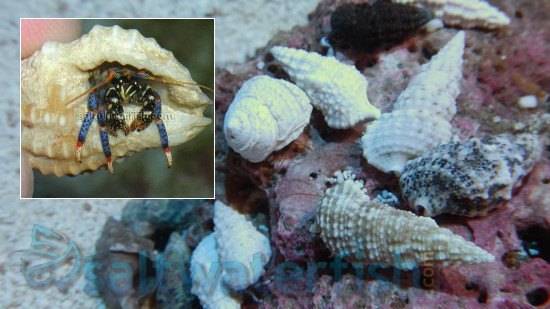Blue Leg Hermit Crab (Clibanarius tricolor)
Quick Stats:
- Care Level: Easy
- Temperament: Peaceful
- Diet: Omnivore
- Reef Safe: Yes
- Minimum Tank Size: 10 gallons
- Max Size: 1 inch
- Water Parameters: pH 8.1-8.4, Salinity 1.023-1.025, Temperature 72-78°F
Comprehensive Guide: Blue Leg Hermit Crab (Clibanarius tricolor)
Habitat
The Blue Leg Hermit Crab, also known as Clibanarius tricolor, is commonly found in the Caribbean Sea and the Western Atlantic Ocean. It inhabits shallow waters, typically living among rocks, rubble, and coral reefs.
Reef Safe
The Blue Leg Hermit Crab is considered reef safe as it does not harm corals or other invertebrates. In fact, it can be beneficial to a reef aquarium as it helps clean up algae and detritus.
Reef Cleaner
The Blue Leg Hermit Crab is considered a reef cleaner because it actively grazes on algae and detritus, helping to maintain a clean and healthy aquarium environment. It is particularly effective in controlling hair algae and cyanobacteria.
Size
The Blue Leg Hermit Crab typically grows up to 1 inch in size, making it a relatively small species suitable for smaller aquarium setups.
Sexual Dimorphism
There is no significant sexual dimorphism in the Blue Leg Hermit Crab, making it difficult to visually distinguish between males and females.
Lifespan
The average lifespan of the Blue Leg Hermit Crab is around 2-3 years, although with proper care, it can live longer.
Diet in Aquariums
The Blue Leg Hermit Crab is an omnivore and will readily consume a variety of foods. In the aquarium, it should be provided with a balanced diet consisting of algae-based foods, meaty foods, and occasional supplements like calcium-rich foods for shell growth.
Aquacultured Availability
The Blue Leg Hermit Crab is commonly aquacultured and readily available to hobbyists. This means that it is sustainably bred in captivity, reducing the impact on wild populations and ensuring a healthier specimen for your aquarium.
Compatibility with Tankmates
The Blue Leg Hermit Crab is generally peaceful and can be kept with a wide range of fish, invertebrates, and corals. However, caution should be exercised with larger predatory fish that may view the crab as food. Here are five popular tankmates for the Blue Leg Hermit Crab:
- Clownfish: Clownfish are compatible tankmates as they generally ignore each other and occupy different areas of the tank.
- Snails: Snails are beneficial tankmates as they also help in algae control and do not compete for the same food sources.
- Soft Corals: Soft corals can coexist with the Blue Leg Hermit Crab as they are not susceptible to its grazing habits.
- Fire Shrimp: Fire Shrimp can be kept with the Blue Leg Hermit Crab as they have similar water parameter requirements and do not pose a threat to each other.
- Clam: Clams can be compatible tankmates as they are filter feeders and do not directly interact with the crab.
Temperament
The Blue Leg Hermit Crab is generally peaceful and non-aggressive. It spends most of its time scavenging for food and cleaning up the aquarium.
Other Common Names
The Blue Leg Hermit Crab is also known as the Tricolor Hermit Crab or simply Blue Leg Crab.
Why Buy from Reefs4Less.com
Reefs4Less.com is a trusted online retailer specializing in saltwater aquarium supplies. They offer a wide range of high-quality products, including the Blue Leg Hermit Crab, at competitive prices. With their excellent customer service and extensive knowledge in the hobby, Reefs4Less.com ensures a seamless shopping experience for saltwater aquarium enthusiasts.
Popular Questions and Answers
Q: Are Blue Leg Hermit Crabs suitable for beginners?
A: Yes, Blue Leg Hermit Crabs are considered an excellent choice for beginners as they are easy to care for and help maintain a clean aquarium.
Q: Can Blue Leg Hermit Crabs be kept in a small tank?
A: Yes, Blue Leg Hermit Crabs can be kept in smaller tanks, but a minimum tank size of 10 gallons is recommended to provide enough space for them to scavenge and explore.
Q: Do Blue Leg Hermit Crabs require supplemental feeding?
A: Blue Leg Hermit Crabs are opportunistic feeders and will scavenge for food in the aquarium. However, it is recommended to provide them with a varied diet to ensure their nutritional needs are met.
Q: Can Blue Leg Hermit Crabs be kept with aggressive fish?
A: It is generally not recommended to keep Blue Leg Hermit Crabs with aggressive or predatory fish that may view them as food. It is best to choose tankmates that are peaceful and compatible.
Q: Do Blue Leg Hermit Crabs molt?
A: Yes, Blue Leg Hermit Crabs molt as part of their growth process. During molting, they shed their old exoskeleton and form a new one.
| Size | Small |
|---|


Reviews
There are no reviews yet.